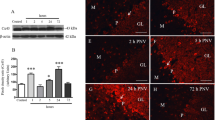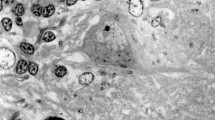Abstract
Chloroquine (CQ) distribution in tissues of acutely poisoned mice was demonstrated by immunohistochemistry using anti-CQ polyclonal antibodies (PAC). PAC recognized 4-amino-7-chloro-quinoline structure and sufficiently reacted with CQ and CQ’s metabolite bisdesethyl-chloroquine. In the brain, CQ and its metabolites (CQs) localized in the region of the choroids plexus, indicating an important role in the blood–cerebrospinal barrier system. In the heart, most regions showed diffused positive staining, and relatively strong reaction was observed in Purkinje cells, indicating an important role in acute CQ toxicity. In the lungs, CQs were observed in the bronchial epithelium, type II pneumocytes, and on the surface of alveolar walls. It was suggested that CQs were excreted to the alveolar wall with surfactant phospholipids, which are produced by type II pneumocytes. In the liver, CQs were concentrated in the centrolobular area rather than in the periportal area, in agreement with CQ’s metabolic pathway. In the kidneys, tubular cells were strongly stained compared to glomerular capsules, and the distal part of renal tubules was better stained than the proximal tubules. These findings suggested that CQs were predominantly excreted or reabsorbed through the distal tubules and the collecting duct. Distribution of CQs in tissues presented here were mostly consistent with the physico-chemical properties of CQ and its metabolites. However, the elucidation of CQs’ localization in Purkinje cells remains open. Further experimental studies at the level of microorganella will be needed to clarify the present result.









Similar content being viewed by others
Notes
http://www.inchem.org/documents/pims/pharm/chloroqu.htm#SubSectionTitle:7.2.2%20Relevant%20animal%20data
References
Araki N, Ueno N, Chakrabarti B, Morino Y, Horiuchi S (1992) Immunochemical evidence for the presence of advanced glycation end products in human lens proteins and its positive correlation with aging. J Biol Chem 267:10211–10214
Ball DE, Tagwireyi D, Nhachi CF (2002) Chloroquine poisoning in Zimbabwe: a toxicoepidemiological study. J Appl Toxicol 22:311–315
Benet LZ, Kroetz DL, Sheiner LB (1996) Pharmacokinetics. In: Hardman JG, Limbird LE, Molinoff PB, Ruddon RW, Goodman Gilman A (eds) Goodman and Gilman’s the pharmacological basis of therapeutics. McGraw-Hill, New York, pp 3–27
Beselt RC (2000) Chloroquine. In: Beselt RC (eds) Disposition of toxic drugs and chemicals in man. Chemical Toxicology Institute, California, pp 165–168
De Letter EA, Espeel MF, Craeymeersch ME, Lambert WE, Clauwaert KM, Dams R, Mortier KA, Piette MH (2003) Immunohistochemical demonstration of the amphetamine derivatives 3,4-methylenedioxymethamphetamine (MDMA) and 3,4-methylenedioxyamphetamine (MDA) in human post-mortem brain tissues and the pituitary gland. Int J Legal Med 117:2–9
Ducharme J, Farinotti R (1996) Clinical pharmacokinetics and metabolism of chloroquine Focus on recent advancements. Clin Pharmacokinet 31:257–274
Fujiwara K, Isobe M, Saikusa H, Nakamura H, Kitagawa T, Takahashi S (1983) Sensitive enzyme immunoassay for the quantification of bleomycin using beta-d-galactosidase as a label. Cancer Treat Rep 67:363–369
Guillon C, Le Bonniec Y (1982) Suicide mode d’emploi: historique, technique, actualité. Moreau editions, Paris
Ishiyama I, Mukaida M, Yoshii T, Suyama H (1987) Histochemical demonstration of methamphetamine by immunocytochemistry. J Forensic Sci 32:658–672
Kaur C (1997) Effects of chloroquine on the ependyma, choroid plexus and epiplexus cells in the lateral ventricles of rats. J Hirnforsch 38:99–106
Muhm M, Stimpfl T, Malzer R, Mortinger H, Binder R, Vycudilik W, Berzlanovich A, Bauer G, Laggner AN (1996) Suicidal chloroquine poisoning: clinical course, autopsy findings, and chemical analysis. J Forensic Sci 41:1077–1079
Nagao M, Takatori T, Wu B, Terazawa K, Gotouda H, Akabane H, Inoue K, Shimizu M (1991) Immunohistochemical localization of paraquat in lung and brain. Med Sci Law 31:61–64
Ohkuma S, Poole B (1981) Cytoplasmic vacuolation of mouse peritoneal macrophages and the uptake into lysosomes of weakly basic substances. J Cell Biol 90:656–664
Projean D, Baune B, Farinotti R, Flinois JP, Beaune P, Taburet AM, Ducharme J (2003) In vitro metabolism of chloroquine: identification of CYP2C8, CYP3A4, and CYP2D6 as the main isoforms catalyzing N-desethylchloroquine formation. Drug Metab Dispos 31:748–754
Riou B, Barriot P, Rimailho A, Baud FJ (1988) Treatment of severe chloroquine poisoning. N Engl J Med 318:1–6
Rowell V, Rowell FJ, Baker A, Laurie D, Sidki AM (1988) A specific ELISA method for determining chloroquine in urine or dried blood spots. Bull World Health Organ 66:211–217
Sanchez-Chapula JA, Navarro-Polanco RA, Culberson C, Chen J, Sanguinetti MC (2002) Molecular determinants of voltage-dependent human ether-a-go-go related gene (HERG) K+ channel block. J Biol Chem 277:23587–23595
Schram G, Pourrier M, Melnyk P, Nattel S (2002) Differential distribution of cardiac ion channel expression as a basis for regional specialization in electrical function. Circ Res 90:939–950
Traebert M, Dumotier B, Meister L, Hoffmann P, Dominguez-Estevez M, Suter W (2004) Inhibition of hERG K+ currents by antimalarial drugs in stably transfected HEK293 cells. Eur J Pharmacol 484:41–48
Treinen-Moslen M (2001) Toxic responses of the liver. In: Klaassen CD (eds), Casarett and Doull’s toxicology, McGraw-Hill, New York, pp 471–489
Wehner F, Wehner HD, Schieffer MC, Subke J (2000a) Immunohistochemical detection of methadone in the human brain. Forensic Sci Int 112:11–16
Wehner F, Wehner HD, Subke J, Meyermann R, Fritz P (2000b) Demonstration of morphine in ganglion cells of the hippocampus from victims of heroin overdose by means of anti-morphine antiserum. Int J Legal Med 113:117–120
Yonemitsu K, Koreeda A, Kibayashi K, Ng’walali PM, Mbonde M, Kitinya J, Tsunenari S (2005) HPLC analysis of anti-malaria agent, chloroquine in blood and tissue from forensic autopsy cases in Tanzania. Legal Med 7:113–116
Young B (2000) Circulatory system. In: Young B, Heath JW (eds) Wheater’s functional histology: a text and colour atlas. Churchill Livingstone, Edinburgh, pp 144–156
Author information
Authors and Affiliations
Corresponding author
Rights and permissions
About this article
Cite this article
Koreeda, A., Yonemitsu, K., Kohmatsu, H. et al. Immunohistochemical demonstration of the distribution of chloroquine (CQ) and its metabolites in CQ-poisoned mice. Arch Toxicol 81, 471–478 (2007). https://doi.org/10.1007/s00204-007-0185-6
Received:
Accepted:
Published:
Issue Date:
DOI: https://doi.org/10.1007/s00204-007-0185-6




